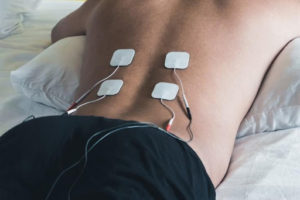The Benefits of TENS Unit Therapy
Anyone who has suffered from chronic back pain understands the sense of absolute desperation for relief. Patients with debilitating back pain are willing to try almost any reasonable suggestion when it comes to pain relief, and many patients are seeking solutions that do not involve potentially addictive prescription medications.
Unless you have been living under a rock for the past decade or so, you know that the U.S. opioid crisis has taken a devastating toll on American families, with a story that has become all too familiar: an opioid prescription is written to alleviate a patient’s pain from an injury or illness, the patient eventually becomes addicted to the pain medication, and the result for many is death by accidental overdose (either from the original medication or from a substance used in its place once the patient can no longer access a prescription).
Many of these stories start with chronic back pain, which is why alternative treatment options are so incredibly important. TENS Unit Therapy is now widely available as a safe and affordable way to treat back pain.
What is a TENS Unit?
A TENS unit is the shortened name for a transcutaneous electrical nerve stimulation device used for the treatment of pain. While the name is certainly a mouthful, one simple definition helps most patients understand how it works.

Transcutaneous simply means “applied across the skin.” Therefore, treatment with a TENS unit involves applying something on the skin versus ingesting something (like an oral medication) or undergoing any type of incision or surgical procedure. The non-invasive nature of pain treatment with a TENS unit is one of its main benefits, which we will discuss more below.
The TENS unit is a small, battery-operated device with electrodes. The electrodes are connected to adhesive pads, which are attached to the patient’s skin. Small electrical impulses are sent through these electrodes, and they interact with the body’s nervous system and provide pain management.
The two primary interactions from these impulses are:
- The nervous system is temporarily unable to send out as many pain signals from the brain to various parts of the body as it is flooded with incoming impulses.
- The impulses stimulate the production of endorphins, which act as one of our body’s natural pain relievers.
A TENS unit can be customized for the individual patient thanks to these adjustable features:
- Duration (measured in the number of microseconds when an electric current is passed through the skin during each pulse of the unit)
- Intensity (the amount of electrical stimulation)
- Frequency (the number of electrical pulses per second, which is adjusted based on whether the pain is chronic or acute)
All adjustments and customization of TENS units should be done with the guidance of your physician. Always use the device exactly as your healthcare provider has instructed.
TENS Unit Precautions
While a TENS unit is safe for many patients to treat pain, there are some precautions to consider and discuss with your healthcare provider before using the device.

Certain conditions can be exacerbated or complicated by the stimulation of a TENS unit, so these people should NOT use them:
- Patients with heart problems
- Patients with epilepsy
- Patients with pacemakers or any other metal or electrical implants
Additionally, a pregnant woman should not use a TENS device around her abdominal and pelvic regions.
The electrodes should never be used on the front of your neck or on your eyes. If placed on the neck they could lower blood pressure and result in spasms. Placement on the eyes could cause a serious injury.
The adhesive pads can cause skin irritation for some people using TENS devices, and there are hypoallergenic pads that can be used in those cases. A TENS unit can also be uncomfortable for some who dislike the prickling or tingling sensation that can be caused by the electrical impulses.
The Top Seven Benefits of TENS Units (700)
A TENS unit can be useful in treating pain caused by a variety of conditions, from the pain that comes with a woman’s menstrual cycle to pain associated with arthritis, and from cancer pain to muscle atrophy. Joint pain as well as neck and back pain are common reasons people look to the stimulation of a TENS unit as a source of relief.
There are many benefits associated with the use of TENS units, and this kind of treatment can be extremely helpful to those who suffer from chronic pain.
Pain Relief without Medication
TENS unit therapy offers an alternative for those who need to treat pain but wish to avoid the dangers of prescription medications. Chronic pain can often lead to opioid addiction, and many healthcare providers and patients are in search of safer alternatives, which is one of the main benefits of TENS unit therapy.
Affordable and Portable
Healthcare costs are continually on the rise, and for patients with chronic pain or serious injury, medical bills can become overwhelming. TENS units are an affordable treatment option, and the fact that they are small and portable also makes them easy to use.
Reduces Inflammation
Inflammation is at the root of many health problems. It can cause tremendous pain and discomfort, and the stimulation from a TENS device can work to reduce inflammation in the body.
Retrains Nerves
Another benefit that comes from using TENS units to manage pain is the fact that our nerves can ultimately be retrained. TENS units have an impact on the way our body understands and sends a pain signal. People who have experienced nerve damage may be candidates for TENS unit therapy.
Non-Invasive Technique
One of the greatest benefits of TENS units is the fact that the technique is non-invasive. A pain relief option that does not involve incisions, surgical procedures, and extended recovery times is easy and convenient for people with busy schedules.
Improves Sleep
Poor sleep quality and ongoing fatigue are also at the root of many of our health problems. Proper rest is one of the most important ways our bodies heal themselves from pain, illness, and injury. A TENS device can ultimately help with sleep as it reduces pain, which can disrupt rest.

Works for a Wide Variety of Conditions
Another reason TENS units are growing in popularity for pain treatment is the fact that they can work for so many different conditions. TENS devices are used on patients with everything from sports injuries to fibromyalgia.
Other Non-Invasive Ways to Relieve Back Pain
Along with the stimulation provided by the impulses from a TENS unit, there are some other practices you can adopt as part of your daily routine to reduce your back pain.
Regular exercise is proven to reduce pain, and even a short daily walk can make a tremendous difference. The use of hot and cold can also be effective in addressing back pain, though you should never do this simultaneously with your TENS device. Heating pads alternated with ice packs are a popular form of relief for those with back pain, especially when it is caused by an injury or strain.
Never underestimate the importance of good shoes when it comes to managing back pain. Your footwear could be the culprit when it comes to not only pain in your feet but also your back. Swapping out the stilettos for a more sensible shoe, at least temporarily, can help reduce pain and stress on your back.
A healthy diet, good hydration habits, and adequate rest are also crucial when it comes to managing body pain, illness, or injury.
If you work in an office and suffer from chronic back pain, you should also evaluate your desk and chair to see if they might be exacerbating your pain. An ergonomically designed workspace can reduce back pain and investing in the right type of chair (and also practicing good posture) can help.
Slumping over a desk all day will inevitably lead to neck, back, and shoulder pain after extended periods, so it is important to focus on your posture and also be sure you are getting up regularly for a short movement break.
Final TENS Tips and Summary
Be sure to use your TENS device exactly as instructed by both the manufacturer and your physician. Your healthcare provider should always be consulted before you try a TENS unit or any other new medical treatments.
Pad placement is important to ensure the best result, so you may need to try a few different placements before you determine what works best for your specific needs. For example, if using a TENS device to treat pain associated with sciatica, you may need to place one pad at your lower back and another on your leg. You should avoid placing the pads on your elbows, knees, and ankles where joint movement could disrupt pad placement and the effectiveness of the treatment.
A TENS device is a safe, affordable, and non-invasive method for managing back pain as well as many other types of pains. If you think you may be a good candidate to use this type of device, ask your doctor about any specific precautions to consider.